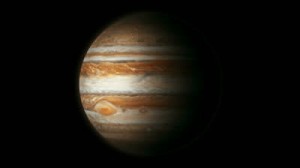Facts About Jupiter The Planet
When Galileo Galilei discovered Jupiter in 1610, it is doubtful that he was aware of the impact this giant planet had on the surrounding solar system. From altering the evolution of Mars to preventing the formation of a ninth planet, the size and mass of Jupiter has seen it exert an influence on its neighbours second only to the Sun.
Jupiter’s mass and composition almost more closely resemble a star than a planet, and in fact if it was 80 times more massive it would be classified as the former. It can virtually be regarded as being the centre of its own miniature solar system: 50 moons to date are known to orbit this gas giant, with the four largest (Io, Europa, Ganymede and Callisto, the Galilean satellites) each surpassing Pluto in size.
The comparison of Jupiter to a star owes a lot to the fact that it is composed almost entirely of gas. It has a large number of ammonia-based clouds floating above water vapour, with strong east-west winds in the upper atmosphere pulling these climate features into dark and light stripes. The majority of its atmosphere, however, is made up of hydrogen and helium.
The strength of Jupiter’s gravity is such that it is held responsible for much of the development of nearby celestial bodies. The gravitational force of the gas giant is believed to have stunted the growth of Mars, consuming material that would have contributed to its size. It also prevented a new planet forming between these two and instead gave rise to the asteroid belt.
 Much of our knowledge of Jupiter comes from seven spacecraft missions to visit the planet, starting with NASA’s Pioneer 10 in 1973. The only man-made object to orbit the planet is the Galileo spacecraft, which studied the planet from 1995 until 2003, when it was sent crashing into Jupiter so as not to contaminate its moons with the debris.
Much of our knowledge of Jupiter comes from seven spacecraft missions to visit the planet, starting with NASA’s Pioneer 10 in 1973. The only man-made object to orbit the planet is the Galileo spacecraft, which studied the planet from 1995 until 2003, when it was sent crashing into Jupiter so as not to contaminate its moons with the debris.
The Great Red Spot
One of Jupiter’s most iconic features is the Great Red Spot, a storm more than twice the size of Earth that has been raging for hundreds of years. The redness is believed to be the result of compounds being brought up from deeper inside Jupiter, which turn brown and red upon exposure to the Sun. Although once highly elliptical in shape, it has become squashed in recent years for unknown reasons and is expected to become circular other the next few decades, although this anti-cyclonic storm shows no sign of dying out any time soon.
![Jupiter The Planet Jupiter The Planet]() Facts about Jupiter
Facts about Jupiter
Orbit radius – 778,340,821km
Radius – 69,911km
One Jupiter year – 11.86yrs
Metallic hydrogen – A third of the way into the planet can be found hydrogen gas that has been compressed into a metallic and electrically conducting liquid.
Atmosphere – The large majority of the atmosphere is composed of hydrogen and helium gas, directly observed by the Galileo space probe that pierced its atmosphere in 1995.
Magnetic field – The magnetic field of Jupiter is 20,000 times stronger than Earth’s, containing a huge number of charged particles that contribute to giant auroras at its north and south poles.
Magnetosphere – The tail of Jupiter’s magnetosphere (the influence of its magnetic field) stretches more than 1 billion kilometres (600 million miles) away from the Sun, out to the orbit of Saturn.
Ring structure – The rings consist of a main, flat ring and an inner cloud-like ring, known as a halo, with both made from small, dark particles kicked up by meteorites hitting Jupiter’s moons.
Rings – NASA’s deep-space Voyageri spacecraft surprised astronomers in 1979 when it found rings encircling Jupiter. The rings are only visible in sunlight.
Aurora – An intense radiation belt of electrons and ions are trapped by Jupiter’s magnetic field, influencing jupiter’s rings and its surrounding moons.

